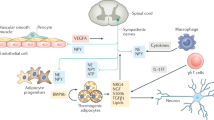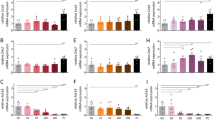Abstract
Background:
Despite successful preclinical testing, 85% of early clinical trials for novel drugs fail. Most futilities originate from molecular mechanisms of the drug(s) tested. It is critically important to develop validated human cell-based model systems in which animal-based research can be translated in order to complement the preclinical in vivo findings prior to implementation of a clinical trial. Obesity is associated with reduced circulating levels of Orexin-A (OX-A) in humans. OX-A increases thermogenesis in rodent brown adipose tissue (AT), yet this phenomenon has not been explored in humans.
Methods:
We established a cell-based model system of human brown and white adipocytes and tested the effects of OX-A on thermogenesis.
Results:
Contrary to published in vivo and in vitro reports in rodents, OX-A treatment alone or in combination with an adrenergic stimulus did neither enhance thermogenesis nor its related transcriptional program in a human in vitro model of brown adipocytes or AT explants.
Conclusions:
Translating preclinical findings in human model systems poses a challenge that must be overcome for the development of effective therapeutic compounds and targets.
This is a preview of subscription content, access via your institution
Access options
Subscribe to this journal
Receive 12 print issues and online access
$259.00 per year
only $21.58 per issue
Buy this article
- Purchase on Springer Link
- Instant access to full article PDF
Prices may be subject to local taxes which are calculated during checkout





Similar content being viewed by others
References
de Lecea L, Huerta R . Hypocretin (orexin) regulation of sleep-to-wake transitions. Front Pharmacol 2014; 5: 16.
Kotz C, Nixon J, Butterick T, Perez-Leighton C, Teske J, Billington C . Brain orexin promotes obesity resistance. Ann NY Acad Sci 2012; 1264: 72–86.
Mahler SV, Smith RJ, Moorman DE, Sartor GC, Aston-Jones G . Multiple roles for orexin/hypocretin in addiction. Prog Brain Res 2012; 198: 79–121.
Teske JA, Billington CJ, Kotz CM . Mechanisms underlying obesity resistance associated with high spontaneous physical activity. Neuroscience 2014; 256: 91–100.
Ammoun S, Holmqvist T, Shariatmadari R, Oonk HB, Detheux M, Parmentier M et al. Distinct recognition of OX1 and OX2 receptors by orexin peptides. J Pharmacol Exp Ther 2003; 305: 507–514.
Sellayah D, Bharaj P, Sikder D . Orexin is required for brown adipose tissue development, differentiation, and function. Cell Metab 2011; 14: 478–490.
Balasko M, Szelenyi Z, Szekely M . Central thermoregulatory effects of neuropeptide Y and orexin A in rats. Acta Physiol Hung 1999; 86: 219–222.
Yoshimichi G, Yoshimatsu H, Masaki T, Sakata T . Orexin-A regulates body temperature in coordination with arousal status. Exp Biol Med (Maywood) 2001; 226: 468–476.
Hara J, Beuckmann CT, Nambu T, Willie JT, Chemelli RM, Sinton CM et al. Genetic ablation of orexin neurons in mice results in narcolepsy, hypophagia, and obesity. Neuron 2001; 30: 345–354.
Funato H, Tsai AL, Willie JT, Kisanuki Y, Williams SC, Sakurai T et al. Enhanced orexin receptor-2 signaling prevents diet-induced obesity and improves leptin sensitivity. Cell Metab 2009; 9: 64–76.
Sellayah D, Sikder D . Orexin receptor-1 mediates brown fat developmental differentiation. Adipocyte 2012; 1: 58–63.
Adam JA, Menheere PP, van Dielen FM, Soeters PB, Buurman WA, Greve JW . Decreased plasma orexin-A levels in obese individuals. Int J Obes Relat Metab Disord 2002; 26: 274–276.
Nishino S, Ripley B, Overeem S, Nevsimalova S, Lammers GJ, Vankova J et al. Low cerebrospinal fluid hypocretin (Orexin) and altered energy homeostasis in human narcolepsy. Ann Neurol 2001; 50: 381–388.
Bronsky J, Nedvidkova J, Zamrazilova H, Pechova M, Chada M, Kotaska K et al. Dynamic changes of orexin A and leptin in obese children during body weight reduction. Physiol Res 2007; 56: 89–96.
Digby JE, Chen J, Tang JY, Lehnert H, Matthews RN, Randeva HS . Orexin receptor expression in human adipose tissue: effects of orexin-A and orexin-B. J Endocrinol 2006; 191: 129–136.
Jespersen NZ, Larsen TJ, Peijs L, Daugaard S, Homoe P, Loft A et al. A classical brown adipose tissue mRNA signature partly overlaps with brite in the supraclavicular region of adult humans. Cell Metab 2013; 17: 798–805.
Wu J, Bostrom P, Sparks LM, Ye L, Choi JH, Giang AH et al. Beige adipocytes are a distinct type of thermogenic fat cell in mouse and human. Cell 2012; 150: 366–376.
Hanssen MJ, van der Lans AA, Brans B, Hoeks J, Jardon KM, Schaart G et al. Short-term cold acclimation recruits brown adipose tissue in obese humans. Diabetes 2016; 65: 1179–1189.
Hanssen MJ, Wierts R, Hoeks J, Gemmink A, Brans B, Mottaghy FM et al. Glucose uptake in human brown adipose tissue is impaired upon fasting-induced insulin resistance. Diabetologia 2015; 58: 586–595.
Gibb S . Toxicity testing in the 21st century: a vision and a strategy. Reprod Toxicol 2008; 25: 136–138.
Mak IW, Evaniew N, Ghert M . Lost in translation: animal models and clinical trials in cancer treatment. Am J Transl Res 2014; 6: 114–118.
Bogacka I, Xie H, Bray GA, Smith SR . Pioglitazone induces mitochondrial biogenesis in human subcutaneous adipose tissue in vivo. Diabetes 2005; 54: 1392–1399.
Sparks LM, Ukropcova B, Smith J, Pasarica M, Hymel D, Xie H et al. Relation of adipose tissue to metabolic flexibility. Diabetes Res Clin Pract 2009; 83: 32–43.
Lee MJ, Wu Y, Fried SK . A modified protocol to maximize differentiation of human preadipocytes and improve metabolic phenotypes. Obesity (Silver Spring) 2012; 20: 2334–2340.
Skrzypski M, T Le T, Kaczmarek P, Pruszynska-Oszmalek E, Pietrzak P, Szczepankiewicz D et al. Orexin A stimulates glucose uptake, lipid accumulation and adiponectin secretion from 3T3-L1 adipocytes and isolated primary rat adipocytes. Diabetologia 2011; 54: 1841–1852.
Shen Y, Zhao Y, Zheng D, Chang X, Ju S, Guo L . Effects of orexin A on GLUT4 expression and lipid content via MAPK signaling in 3T3-L1 adipocytes. J Steroid Biochem Mol Biol 2013; 138: 376–383.
Yu G, Floyd ZE, Wu X, Hebert T, Halvorsen YD, Buehrer BM et al. Adipogenic differentiation of adipose-derived stem cells. Methods Mol Biol 2011; 702: 193–200.
Tews D, Schwar V, Scheithauer M, Weber T, Fromme T, Klingenspor M et al. Comparative gene array analysis of progenitor cells from human paired deep neck and subcutaneous adipose tissue. Mol Cell Endocrinol 2014; 395: 41–50.
Bortolotto JW, Margis R, Ferreira AC, Padoin AV, Mottin CC, Guaragna RM . Adipose tissue distribution and quantification of PPARbeta/delta and PPARgamma1-3 mRNAs: discordant gene expression in subcutaneous, retroperitoneal and visceral adipose tissue of morbidly obese patients. Obes Surg 2007; 17: 934–940.
Betz MJ, Slawik M, Lidell ME, Osswald A, Heglind M, Nilsson D et al. Presence of brown adipocytes in retroperitoneal fat from patients with benign adrenal tumors: relationship with outdoor temperature. J Clin Endocrinol Metab 2013; 98: 4097–4104.
Komolka K, Albrecht E, Wimmers K, Michal JJ, Maak S . Molecular heterogeneities of adipose depots—potential effects on adipose-muscle cross-talk in humans, mice and farm animals. J Genomics 2014; 2: 31–44.
Cypess AM, White AP, Vernochet C, Schulz TJ, Xue R, Sass CA et al. Anatomical localization, gene expression profiling and functional characterization of adult human neck brown fat. Nat Med 2013; 19: 635–639.
Lee P, Swarbrick MM, Zhao JT, Ho KK . Inducible brown adipogenesis of supraclavicular fat in adult humans. Endocrinology 2011; 152: 3597–3602.
Shinoda K, Luijten IH, Hasegawa Y, Hong H, Sonne SB, Kim M et al. Genetic and functional characterization of clonally derived adult human brown adipocytes. Nat Med 2015; 21: 389–394.
Tupone D, Madden CJ, Cano G, Morrison SF . An orexinergic projection from perifornical hypothalamus to raphe pallidus increases rat brown adipose tissue thermogenesis. J Neurosci 2011; 31: 15944–15955.
Bronsky J, Nedvidkova J, Krasnicanova H, Vesela M, Schmidtova J, Koutek J et al. Changes of orexin A plasma levels in girls with anorexia nervosa during eight weeks of realimentation. Int J Eat Disord 2011; 44: 547–552.
Lafontan M, Barbe P, Galitzky J, Tavernier G, Langin D, Carpene C et al. Adrenergic regulation of adipocyte metabolism. Hum Reprod 1997; 12 (Suppl 1): 6–20.
Chen J, Randeva HS . Genomic organization and regulation of the human orexin (hypocretin) receptor 2 gene: identification of alternative promoters. Biochem J 2010; 427: 377–390.
Nedergaard J, Golozoubova V, Matthias A, Shabalina I, Ohba K, Ohlson K et al. Life without UCP1: mitochondrial, cellular and organismal characteristics of the UCP1-ablated mice. Biochem Soc Trans 2001; 29 (Pt 6): 756–763.
Yehuda-Shnaidman E, Buehrer B, Pi J, Kumar N, Collins S . Acute stimulation of white adipocyte respiration by PKA-induced lipolysis. Diabetes 2010; 59: 2474–2483.
Blondin DP, Frisch F, Phoenix S, Guerin B, Turcotte EE, Haman F et al. Inhibition of intracellular triglyceride lipolysis suppresses cold-induced brown adipose tissue metabolism and increases shivering in humans. Cell Metab 2017; 25: 438–447.
DiMasi JA, Grabowski HG, Hansen RW . Innovation in the pharmaceutical industry: new estimates of R&D costs. J Health Econ 2016; 47: 20–33.
Scannell JW, Blanckley A, Boldon H, Warrington B . Diagnosing the decline in pharmaceutical R&D efficiency. Nat Rev Drug Discov 2012; 11: 191–200.
Sellayah D, Sikder D . Feeding the heat on brown fat. Ann NY Acad Sci 2013; 1302: 11–23.
Acknowledgements
We thank the study volunteers and patients for their participation. This study was funded by an internal Strategic Protocol from the Translational Research Institute for Metabolism and Diabetes (no. TRI-SP-14-01) (to LMS).
Author contributions
Conceptualization, LMS and SRS; methodology, MFP, AD, AVS and LMS; investigation, MFP, AD, AVS and LMS; writing—original draft, LMS and MFP; writing—review and editing, MFP, AD, AVS, SRS and LMS; funding acquisition, LMS; resources, AVS, SRS and LMS; supervision, LMS.
Author information
Authors and Affiliations
Corresponding author
Ethics declarations
Competing interests
The authors declare no conflict of interest.
Additional information
Supplementary Information accompanies this paper on International Journal of Obesity website
Supplementary information
Rights and permissions
About this article
Cite this article
Pino, M., Divoux, A., Simmonds, A. et al. Investigating the effects of Orexin-A on thermogenesis in human deep neck brown adipose tissue. Int J Obes 41, 1646–1653 (2017). https://doi.org/10.1038/ijo.2017.155
Received:
Revised:
Accepted:
Published:
Issue Date:
DOI: https://doi.org/10.1038/ijo.2017.155
This article is cited by
-
Obesity: a neuroimmunometabolic perspective
Nature Reviews Endocrinology (2020)
-
BAT is independently affected by peripheral and central pathways
International Journal of Obesity (2018)



